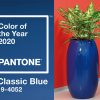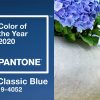Introducing 2020, Pantone’s Classic Blue offers us a quiet confidence for a new era. This enduring hue highlights our desire for a dependable and stable foundation. In the garden blooming plants such as hyacinths, muscari, iris, delphinium, pericallis, and hydrangea are poised and remind us that this blue hue is elegant in its simplicity. The versatility of the color takes on distinct appearances through different materials, finishes, and textures. From accent textiles to glazed ceramic pottery, PANTONE 19-4052 Classic Blue makes a dramatic statement, transforming a space through unique color combinations and tonal statements.






